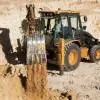
Indian Railways faces surge in equipment failures during first quarter

Indian Real Estate Sector Sees Highest Capital Inflow in Seven Years
Equirus Capital, a leading full-service investment banking firm, has reported that India’s real estate sector has witnessed its highest capital inflow in seven years, with funds raised reaching ₹23,080 crore across 12 deals.According to Equirus Capital’s analysis, the cumulative capital raised by the sector since FY18 stands at ₹72,331 crore. Of this, Real Estate Investment Trusts (REITs) accounted for the largest share at ₹31,241 crore, followed by large-cap real estate companies at ₹20,437 crore, mid-cap players at ₹12,496 crore, and small-cap firms contributing ₹8,156 crore...

India’s Flex Office Market Set for Record Growth
myHQ by ANAROCK, India’s largest workspace discovery and flexible office solutions platform, has released its Flex Office Market in India 2025 Report, revealing that India is set to become the Asia-Pacific region’s largest flexible office market. The report highlights how flexible workspaces have become a mainstream component of India’s commercial real estate, capturing a growing share of national leasing activity.“Flexible workspaces have evolved from a cost-optimisation tool to a strategic necessity,” said Utkarsh Kawatra, CEO and Co-Founder, myHQ by ANAROCK. “Average corporate d..

India Defies Regional Slowdown; Office Leasing on Track for Record High in 2025
India’s office market continues to outperform the broader Asia-Pacific region, emerging as a key growth driver amid regional headwinds, according to Knight Frank’s Asia-Pacific Office Highlights Q3 2025 report. With 8.8 million sq. ft. transacted in the third quarter alone, leasing momentum remains robust. Full-year volumes across Bengaluru, NCR, and Mumbai are projected to reach 50 million sq. ft., surpassing the previous record of 41 million sq. ft. set in 2024.The surge has been fuelled by sustained leasing from Global Capability Centres (GCCs) and renewed activity from third-party IT s..
















